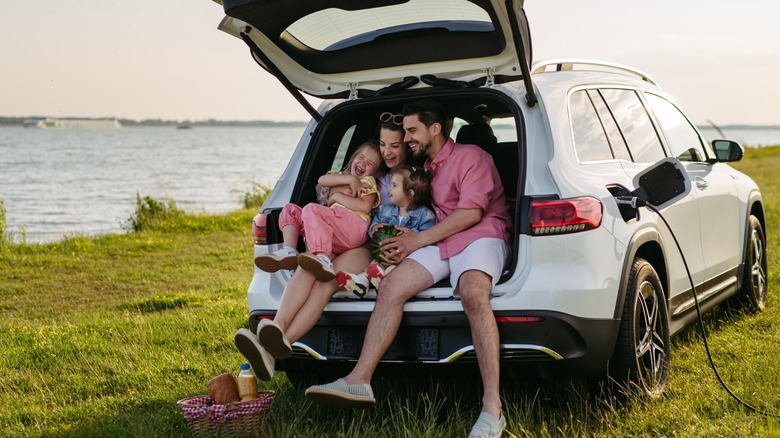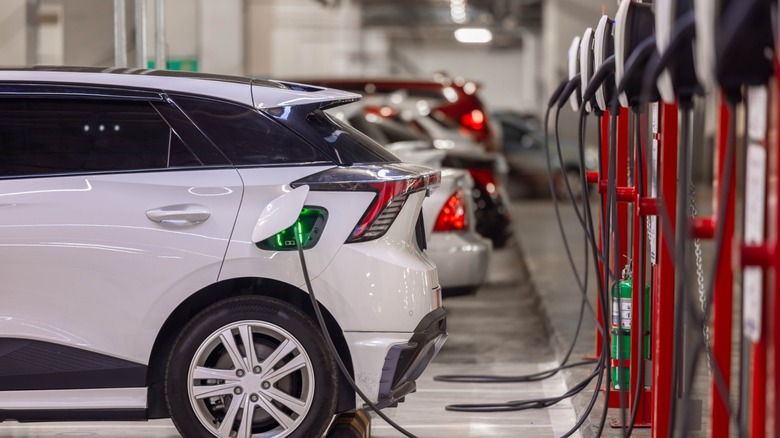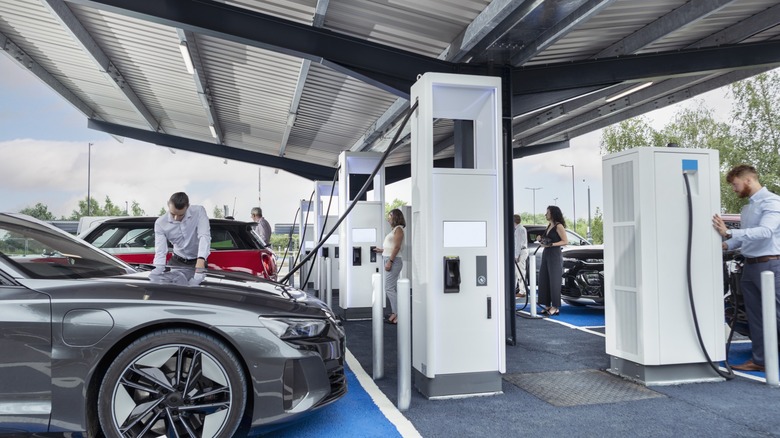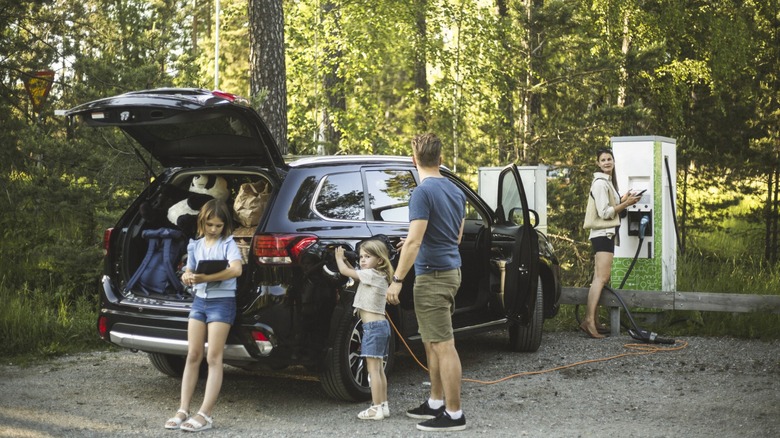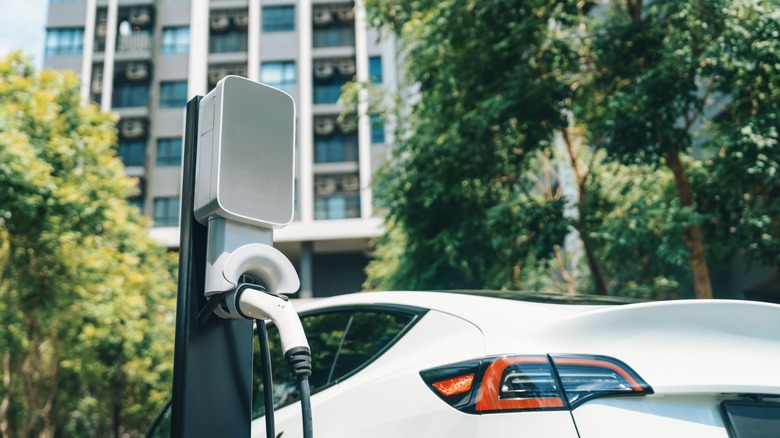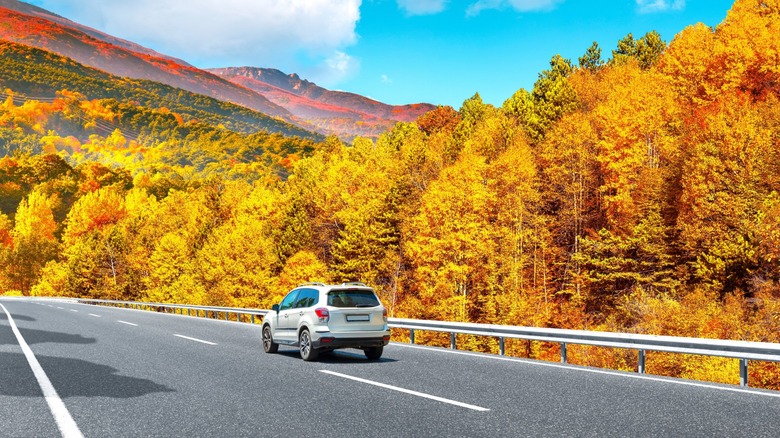Secrets You Should Know About Road-Tripping In An EV
Years ago, planning a road trip always included an obnoxious factor: Where are the gas stations along the route? After all, you don't want to be stuck between potential stops with the needle hovering below the dreaded "E." While the advent of electric vehicles has altered that worry, it hasn't really lessened it. Rather, you're just asking yourself a different version of the same question: Where are the charging stations along the route?
While taking an EV on a road trip is more cost-effective, with charging costing about 60% less than gas each year, the concern over charging station availability is valid. There is also the issue of time, as charging an EV can more than triple the time spent at a stop, and that's a low estimate assuming you spend about five minutes at a gas pump and only 15 to 30 at a charging station. All of this makes the notion of road-tripping in an electric vehicle sound like more of a headache. However, if you know the ins and outs of hitting the road in an EV, you can still make the most of the trip.
If you're thinking of taking your EV out on an extensive road trip, keep some of these tips and secrets in the back of your mind. They'll either give you peace of mind, make the trip more pleasant, or prevent any unwelcome surprises that come with long-distance traveling in an EV.
Calculating range isn't an exact science
Yes, car manufacturers can tell you that your EV battery should last so many miles. The problem with that figure is that it's a straight line at a steady pace with no variables factored in. Calculating the range is simple math, where you divide the battery's capacity by its kWh per 100 miles rating, then multiply it by 100. Unfortunately, those numbers are only a fraction of the equation. There are many factors that can result in a shorter or longer range, such as your average speed and the age of the battery. Even routes with more uphill stretches and heavier car loads will impact how far your EV will drive.
Since you can't possibly know the exact moment your EV will die on the road, always give an allowance between charging station stops. You should have at least a 10% charge buffer to help accommodate for unexpected hindrances to the vehicle's efficiency. This is especially important during long stretches where charging stations may be few and far between.
While that may add a little stress to the road trip, here's a fun fact to perk you up. Electric vehicles are actually more efficient than gas-powered cars during traffic jams. ICE vehicles burn about half a gallon every hour. An EV will actually idle at a much lower power-consumption rate, sometimes from 50 kilowatts to around one.
Take charging stations when you can find them
While you'll likely pass about 100 gas stations over 1,000 miles, EV charging stations are far more infrequent. The average is about 22 stations per every 1,000 miles, which is especially problematic when you consider the range of your EV. According to the Department of Energy, as of 2022, EVs were capable of running for approximately 400 miles before being completely drained. For internal combustion engine (ICE) vehicles, that range was over 760 miles.
That's not such a problem if you're traveling within a populated city center, as charging stations are far more common. If you're traversing across Montana for a chance to hike through the stunning Glacier National Park, that's a little dicier. There are just over 100 stations in the entire state, with concentrations focused around cities like Helena and Billings. For perspective, there are over 340 stations in Los Angeles alone.
So, if you're in a state with a smaller population, you may need to stop when you see a charger, regardless of how busy it may look. The good thing is the time spent plugged in doesn't have to be a waste.
Turn charging into an experience
As Reddit user u/Craft-Sundae6351 explains, stopping to charge doesn't have to be a big inconvenience. Even if you're waiting 40 minutes, you don't have to just sit around. In their post, they talk about how they'll grab a bite to eat, find a patch of grass to stretch or exercise, or complete an errand at a nearby store. You may perceive stopping to charge to be a chore, but you can make the most of it so you don't feel like any part of your road trip is wasted time.
For example, say you're en route to Prescott, Arizona via Flagstaff and know you'll need to charge before getting to your destination. You have three ways to spend your time charging. You can make sure you're fully charged in Flagstaff and grab a bite downtown, make a stop in Sedona and enjoy a quick hike, or veer off into Clarkdale to explore magnificent historic sites. It's all about utilizing your time wisely. Otherwise, yes, you will be twiddling your thumbs for upwards of 30 to 40 minutes and getting nothing out of that leg of your road trip.
Some hotels have EV chargers
Wouldn't it be great to be able to plug your car in and lounge in a comfortable room while it's charging? Understanding the few perils of traveling with an EV, some hotel chains have started to integrate chargers into their available amenities. Hilton, for example, has over 1,000 properties across the United States, including its Home2 Suites, Hampton Inn, True, and Homewood Suites brands. Rather than having you guess which properties to consider, it offers an easy-to-read map with each location labeled. IHG Hotel & Resorts, Holiday Inn's parent company, offers a similar service, though it has several hundred fewer EV-ready hotels.
When you're planning your route, try to integrate as many EV-ready hotels as possible. It may cut down on the downtime at a charger, so you can make more headway each day. There is a caveat, of course. Have a backup plan, such as a nearby gas station with an EV charger. Just because a hotel offers EV charging doesn't mean they'll be available or functional. A good rule of thumb when it comes to EV chargers is to always have a backup option. For example, if you're staying at the EV-friendly Hampton Inn property at photogenic Big Bear Lake, make a note of the scattering of nearby charging stations. Broken charging stations are a fairly common nuisance, and all it takes is one broken charger to create a line of cars waiting for their turn.
Don't fully charge the battery
It may be against your instinct but don't get your battery to 100%. There are two reasons for this, and both will have an impact on the quality of your road trip. Firstly, manufacturers generally recommend stopping the charge at 80%. A battery that's consistently somewhere between 20 and 80% will last longer than one that's always charged to the max. While it's not immediately damaging to the battery, it can contribute to degradation down the road.
While that's not a guarantee, the second reason why you shouldn't fully charge your battery is. It may sound silly, but a battery takes just as long to go from 80 to 100% as it does from 20 to 80%. So, if you waited 20 minutes for that 60% charge, you'll be waiting another 20 just for that extra 20%. So long as your road trip route can accommodate a battery that's only 80% charged, it's far more efficient in the long run to skip that last leg of charging.
